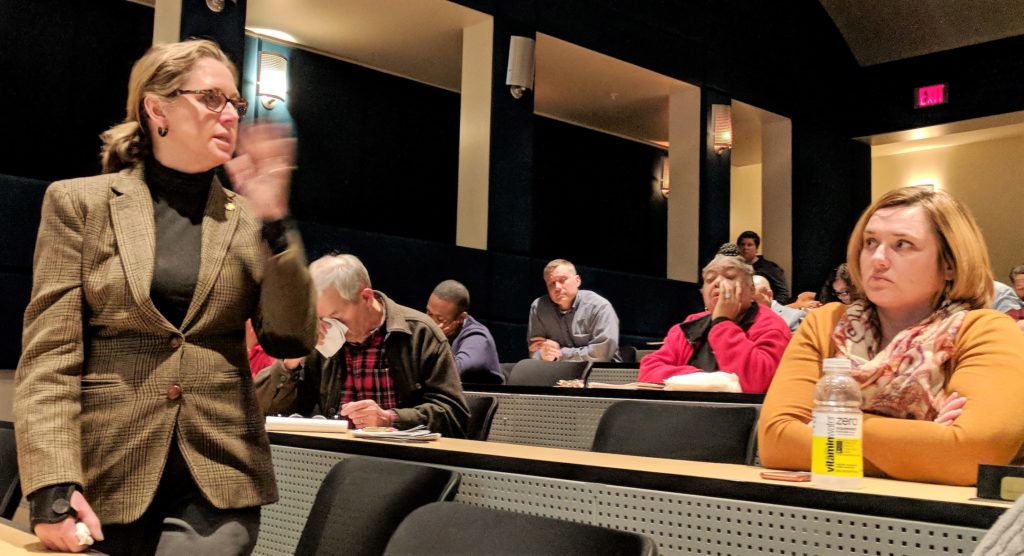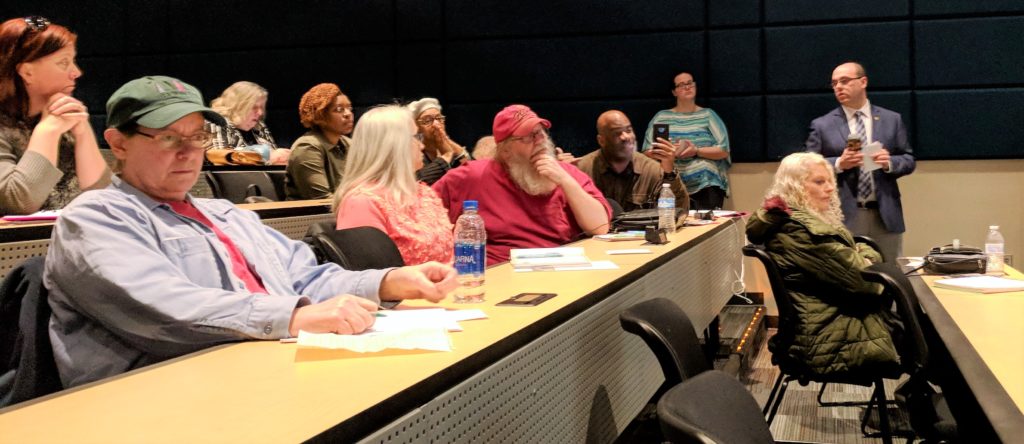By Paul Rozycki
A planned two-hour town hall that ran almost three hours revealed both the hard and complex science behind the PFAS problem, as well as the anger, frustration and distrust over water issues in the Flint area.
The town hall meeting, held at the Mott Community College Regional Tech Center (RTC) Friday March 8, was organized by area state House members John Cherry (D-49th), Sheldon Neeley (D-34th), Sheryl Kennedy (D-48th) and Tim Sneller (D-50th). They brought together members of the Michigan Department of Environmental Quality (MDEQ) and the Department of Health and Human Services (MDHHS). One DEQ spokesperson offered information from the RACER Trust, which has been charged with cleaning up the Buick City brownfield in Flint. The panel spoke to a nearly full auditorium on the campus, about 250 people.

State Representative Sheryl Kennedy addressing a crowd of close to 250 (Photo by Paul Rozycki)
The six members of the panel explained in much scientific detail both the process, and the problems in measuring, and cleaning up those areas affected by the chemicals commonly known as PFAS or polyflouroalkyl substances. There are several varieties of PFAS, and the chemical is used in a wide variety of common materials. Though commonly associated with fire-fighting chemicals, PFAS is also use in stain repellants, waterproof clothing, shoes, fast food wrappers, cosmetics, non-stick cookware and many other consumer goods.
As pointed out by one of the panel members, Deb Mackenzie-Taylor, a toxicology specialist with the Department of Environmental Quality, at higher levels the PFAS chemicals can present a serious health threat.
Each of the six panelists covered a part of the PFAS problem, both as it affects the whole state and as it affects Genesee County.
Steve Sliver, executive director of the Michigan PFAS Action Response Team (MPART) at the DEQ, said that while “there is a lot we don’t know” about the chemical, it does have the ability to cycle through the ecosystem for a long time before breaking down. Measuring it can be challenging. It is considered harmful at any level above 70 parts per trillion (ppt.). To get an idea of how little that is, he said that one part per trillion is equal to one drop of water in an Olympic sized swimming pool.
The next four speakers surveyed what is known about the impact and sources of PFAS in Genesee County.
Stephanie Kammer, also with the DEQ, discussed the presence of PFAS in the Gilkey Creek area, and found that the manufacturing processes at the now closed Delphi plant had caused a spike in chemical levels. At one location, Gilkey Creek tested at a fairly high 25 ppt. level, still well below the 70 ppt. action level. There was some worry over the possibility that those in the area using well water might have some concerns.
Al Taylor, also from the DEQ, spoke about the attempts to clean up a landfill on Coldwater Road and the former Buick City site. His concern was the possibility that those in the area using well water might be impacted. He said the RACER Trust was working with the city and that there would be hearings planned to inform the public and hear comments about the process of the cleanup. However there were no drinking wells in the immediate RACER Buick City area. In the Coldwater Road area, only two wells were found to have exceeded the action limits.
He said that there are plans for further groundwater, storm sewer and soil investigations, and that the Environmental Protection Agency (EPA) would be holding public hearings in the near future on the cleanup options.
Jim Arduin, a solid waste geologist specialist for Richfield Landfill, spoke about the contamination problems at the landfill, off Mt. Morris Road. While there were some spikes in the PFAS level, he also expressed concerns about those using well water, a larger issue in that part of the county. There was some evidence of contamination in upper level wells, but none in the deeper, lower level wells and residential samples found no sign of PFAS.
Paul Bucholtz of the DEQ, reviewed the problems of an old landfill near Bishop Airport that has been absorbing water, and presented some risk to the area. Testing in the summer of 2018 revealed that three of six shallow wells exceeded the 70 ppt. action level, and one was dramatically higher testing at 810 ppt.
Deb Mackenzie-Taylor, a toxicology specialist with the DEQ, concluded the panel’s presentation with a survey of the potential health impacts of PFAS exposure. Among the health effects she discussed were: lower a chance of a woman getting pregnant, higher blood pressure in pregnant women, increased change of thyroid disease, higher cholesterol levels, increased chance of cancer and modified immune response. She recommended that those at risk should use a recommended filter, read consumer labels to avoid using products that contain PFAS. She also presented a list of fish that should be avoided or eaten in moderation, since fish are very prone to absorb PFAS from the water.
The panel presentations were detailed and complex, but when it came to the audience questions there was no hiding the distrust and anger over the water issue.
On one hand Sliver, of the DEQ, said, “We are reducing the PFAS in the water without new major enforcement regulations. We have an aggressive policy to reduce the threat….There is no evidence of a major PFAS problem in the drinking water in the Flint area–though we are still investigating.”

Moderator John Cherry (standing) at PFAS hearing, with Tony Palladeno, Art Woodson and other citizens (Photo by Paul Rozycki)
On the other hand, when it came time for questions from the audience, water activist Tony Palladeno said, “I’ve seen foam on the river (where I fish) and we don’t trust anyone.”
Art Woodson added, “We’re tired of people coming and lying to us.”
Another member of the audience said, “While I hope to gain your trust, this community won’t trust any of you.”
In response to some of the audience comments, State Representative Sheryl Kennedy (D-48th) said, “I understand the trust issue. I can assure you that the attorney general is taking this very seriously.”
At the conclusion, moderator State Representative John Cherry said all the data from the presentation would be available on the websites of the state representatives who were there, as well as at the state of Michigan website for the PFAS issue www.michigan.gov/pfasresponse. The RACER Trust also posts information at www.racertrust.org/buickcity18.
Banner photo (from left): Stephanie Kammer, Al Taylor, Tim Ardun, Paul Bucholtz, Deb Mackenzie-Taylor (Photo by Paul Rozycki)
EVM staff writer and political commentator Paul Rozycki can be reached at paul.rozycki@mcc.edu.


You must be logged in to post a comment.